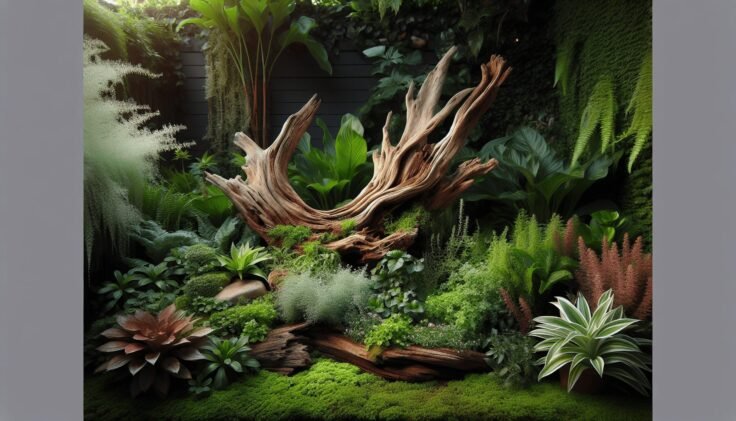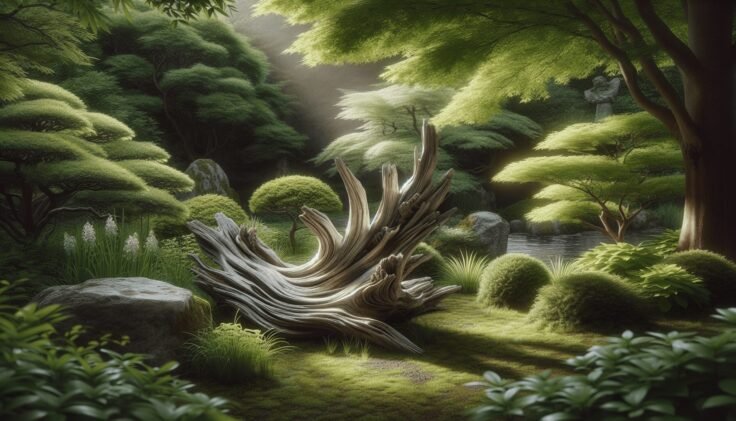Have you ever considered adding a touch of rustic charm and natural beauty to your garden with something as simple as driftwood? The concept of a driftwood garden edge is not only visually appealing but also environmentally friendly. This guide will take you through the benefits, the process of creating, and tips on maintaining a driftwood garden edge.

Understanding Driftwood and Its Uses
What is Driftwood?
Driftwood is wood that has been washed onto the shore of a sea, river, or lake by the action of winds, tides, or waves. Over time, it is weathered and bleached by the sun and water, giving it a unique, silvery appearance. This naturally sculpted form offers an aesthetic that aligns perfectly with the environment, making it an excellent choice for garden edges.
Why Use Driftwood in Your Garden?
Driftwood is not only aesthetically pleasing but also has several practical uses in garden design. Its natural form can help create boundaries, retain soil, or define sections of your garden. Using driftwood has environmental benefits too; by repurposing naturally fallen wood, you reduce the demand for commercially processed garden borders.
Benefits of Driftwood Garden Edging
Natural Aesthetics
There’s something innately beautiful about natural elements incorporated into a garden. Driftwood blends seamlessly with plants, soil, and other organic materials, providing an artistic flair that manufactured garden borders often lack.
Sustainable Choice
Choosing driftwood helps in conserving resources. Since driftwood is naturally occurring and requires no manufacturing, using it reduces your carbon footprint and supports sustainable garden practices.
Cost-Effective
Driftwood can often be collected for free from beaches or lakesides, provided you follow local regulations and guidelines. This makes it a cost-effective option compared to store-bought garden edging materials.
How to Create a Driftwood Garden Edge
Gathering Driftwood
Where to Find Driftwood
The first step in creating a driftwood garden edge is sourcing your driftwood. You can find it along beaches, riverbanks, or lakeshores. Make sure to adhere to any local laws or regulations about collecting natural materials.
Selecting the Right Pieces
Look for pieces that are not too decayed, as they need to withstand the outdoor environment for several years. Choose pieces of varying shapes and sizes to add visual interest and ensure good coverage.
Preparing Driftwood for Your Garden
Cleaning the Driftwood
Before using driftwood in your garden, clean it thoroughly to remove any salt, sand, or algae. You can scrub it with a stiff brush and rinse it with water. Let it dry completely before use.
Treating the Driftwood
To prolong its life, consider treating driftwood with a wood preservative. This will help protect it against the elements and potential insect infestation.
Installing the Driftwood Edge
Designing Your Layout
Start by planning how you would like your driftwood edge to look. Will it be a simple straight line, or do you want it to curve along the contours of your garden bed? Lay out the pieces on the ground before you start digging to ensure you’re happy with the design.
Positioning and Stability
Dig a shallow trench, about a few inches deep, where you wish to place the driftwood. This will ensure the wood is anchored securely. Position the pieces in the trench and pack the soil around them to stabilize.
Incorporating Driftwood into Various Garden Designs
Driftwood in Flower Beds
Driftwood can provide a beautiful contrast to the colors of flowering plants. It can be used as a border or even as a focal point amidst the flowers. It acts as a natural mulch, retaining soil moisture and keeping roots cool.
Vegetable Garden Edging
Define your vegetable patches with a driftwood border. This makes tending to plants easier and adds an element of design to a practical space. Furthermore, driftwood can help keep pests at bay, acting as a deterrent for crawling insects.
Creating Paths and Walkways
Use driftwood to edge pathways, providing visual direction and a rustic texture that invites exploration. Driftwood’s irregular shapes can create intriguing patterns that guide you through your garden journey.

Maintaining Your Driftwood Garden Edge
Regular Inspections
Check your driftwood regularly for signs of decay or insect damage. Timely intervention can save pieces and prolong the life of your garden edging.
Preservative Treatment
Reapply wood preservative every couple of years to maintain the driftwood’s integrity and appearance. This helps keep it resistant both to weather and pests.
Seasonal Care
With seasonal changes, driftwood might shift position. Re-adjust and secure the pieces, especially after heavy rain or snow, to maintain the integrity of your garden edge.
Alternatives and Complements to Driftwood Garden Edging
Using Rocks and Stones
Rocks can be mixed with driftwood to create a more diverse texture in your garden edge. Combining materials can enhance both durability and visual interest.
Plants as Edging
Consider planting low-growing, hardy plants alongside your driftwood. This can soften the edge and invite more biodiversity into your garden.
Upcycling Found Objects
Expand the natural theme by incorporating other natural or reclaimed materials like old bricks or recycled glass into your garden edges. This enables you to have a truly unique garden that reflects your personal style.
Legal and Ethical Considerations
Following Local Laws
Always check local regulations about collecting driftwood. Some areas may have restrictions to protect ecosystems or for cultural reasons.
Being Environmentally Conscious
When collecting driftwood, be mindful not to disrupt local wildlife habitats. Avoid taking pieces that provide shelter or food for local animals.
Driftwood in Broader Landscape Design
Integrating Water Features
Driftwood can be used to accentuate water features like ponds or fountains, further enhancing the natural feel. It serves as a bridge between water and land, providing continuity in your garden design.
Accent Pieces
Beyond edging, larger driftwood pieces can be used as garden sculptures or seating, offering functional and decorative value.
Bird and Wildlife Habitat
Driftwood can support local wildlife by offering shelter and nesting sites. This emphasizes the ecological benefits of incorporating natural materials into your garden.
Tips for Sourcing Driftwood Responsibly
Finding Ethical Sources
If collecting driftwood yourself isn’t feasible or allowed, consider purchasing from suppliers committed to sustainable practices. They often replace collected wood with planted saplings to balance nature’s resources.
Supporting Local Artisans
Seek out local artisans who use driftwood, as buying from them supports small businesses and ensures the wood is sourced responsibly.
Conclusion
Embracing a driftwood garden edge is a wonderful way to blend artistry with nature in your outdoor space. By using driftwood, you’re creating an inviting, sustainable, and visually pleasing environment connected to the beauty of the natural world. Whether you’re edging flower beds, vegetable patches, or pathways, driftwood brings a timeless, earthy charm to your garden. By following ethical sourcing practices and maintaining the wood, you can enjoy your driftwood garden edge for years. Give your garden the unique touch it deserves by integrating the ageless beauty of driftwood.



